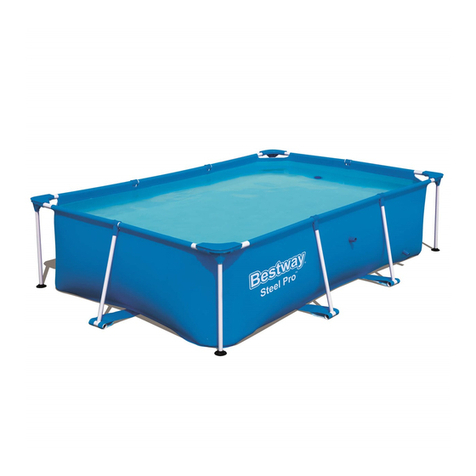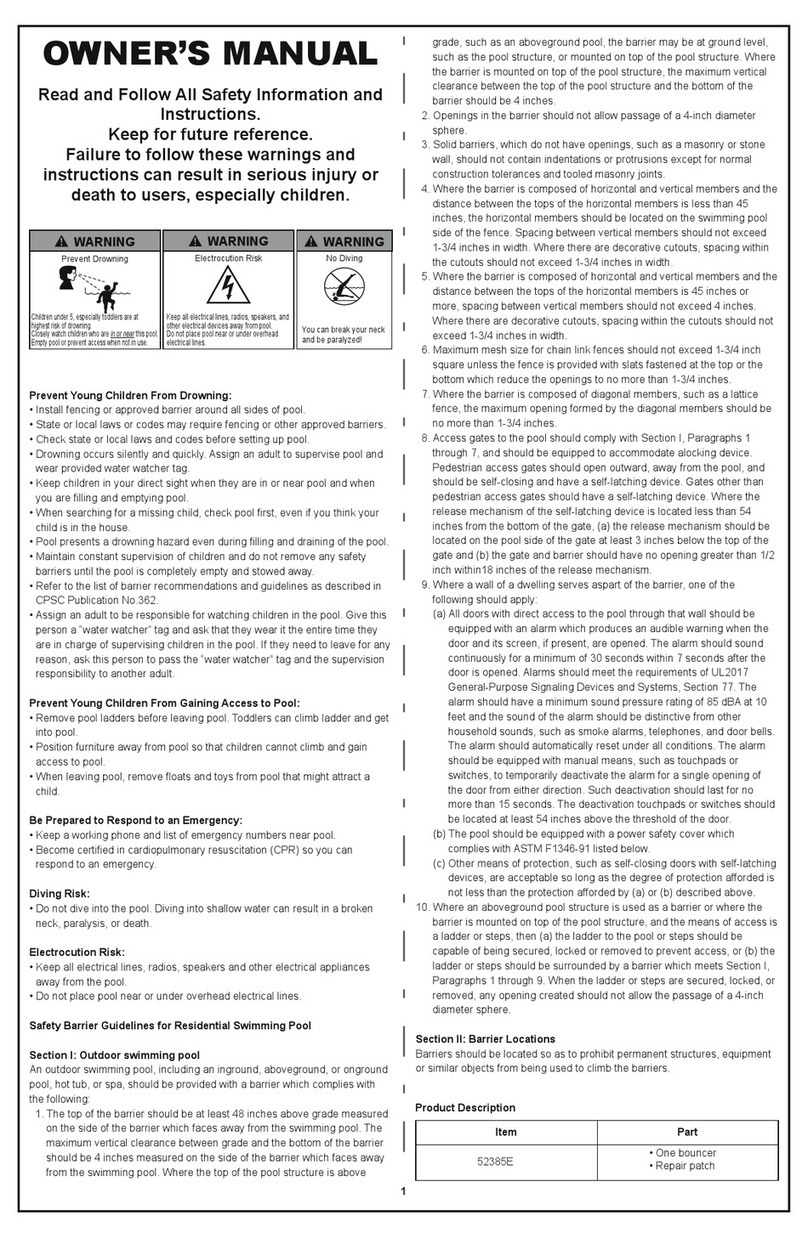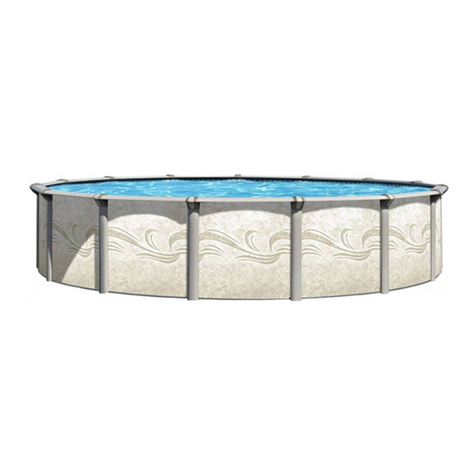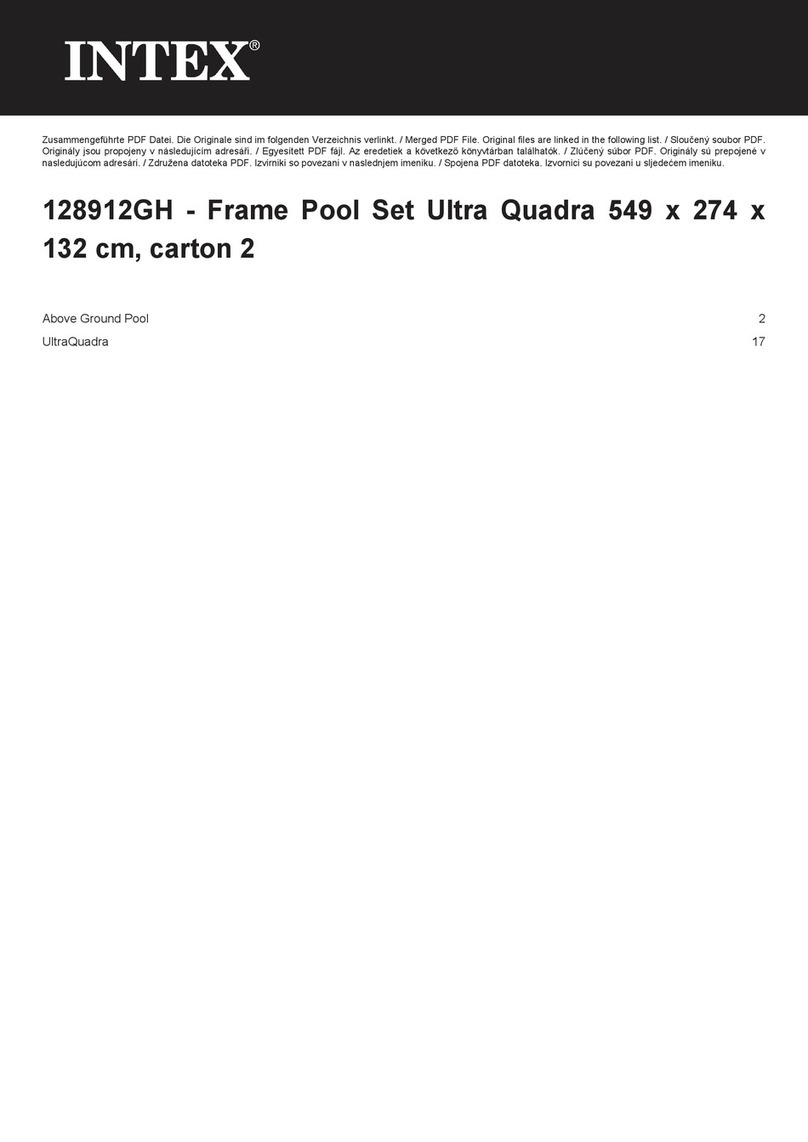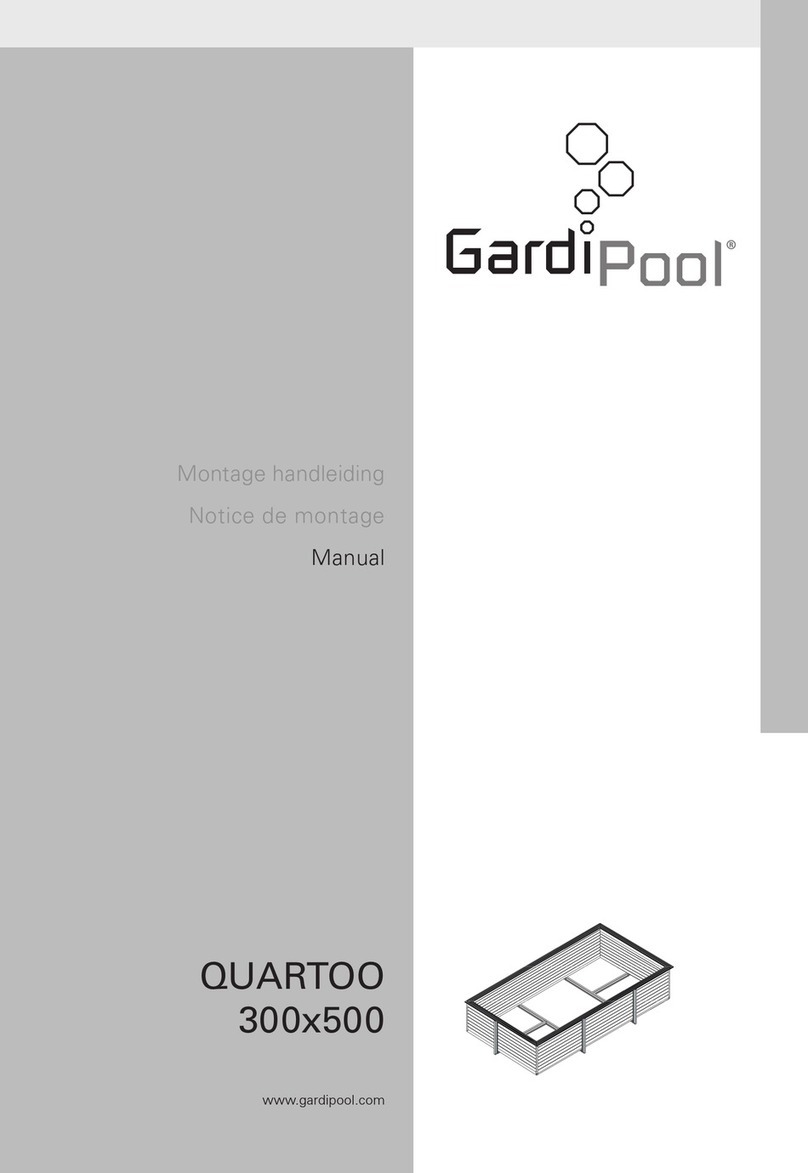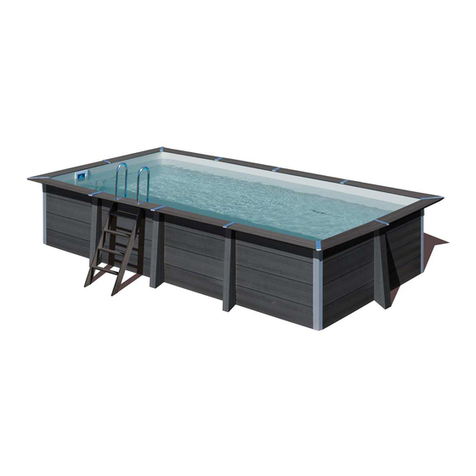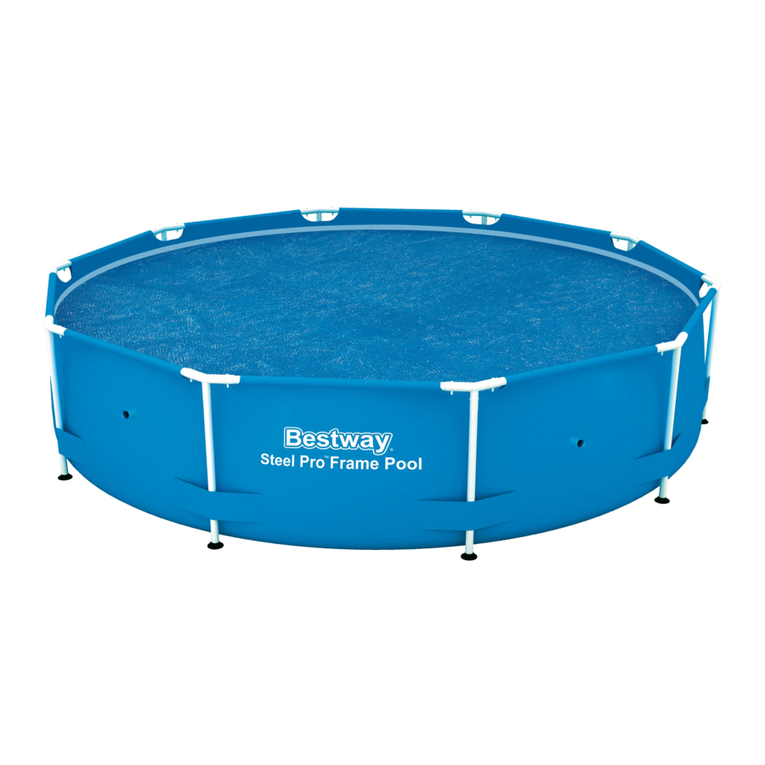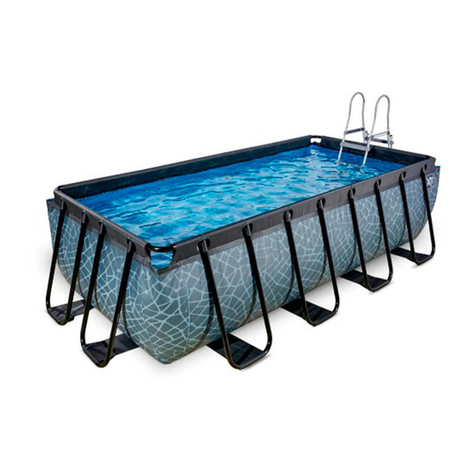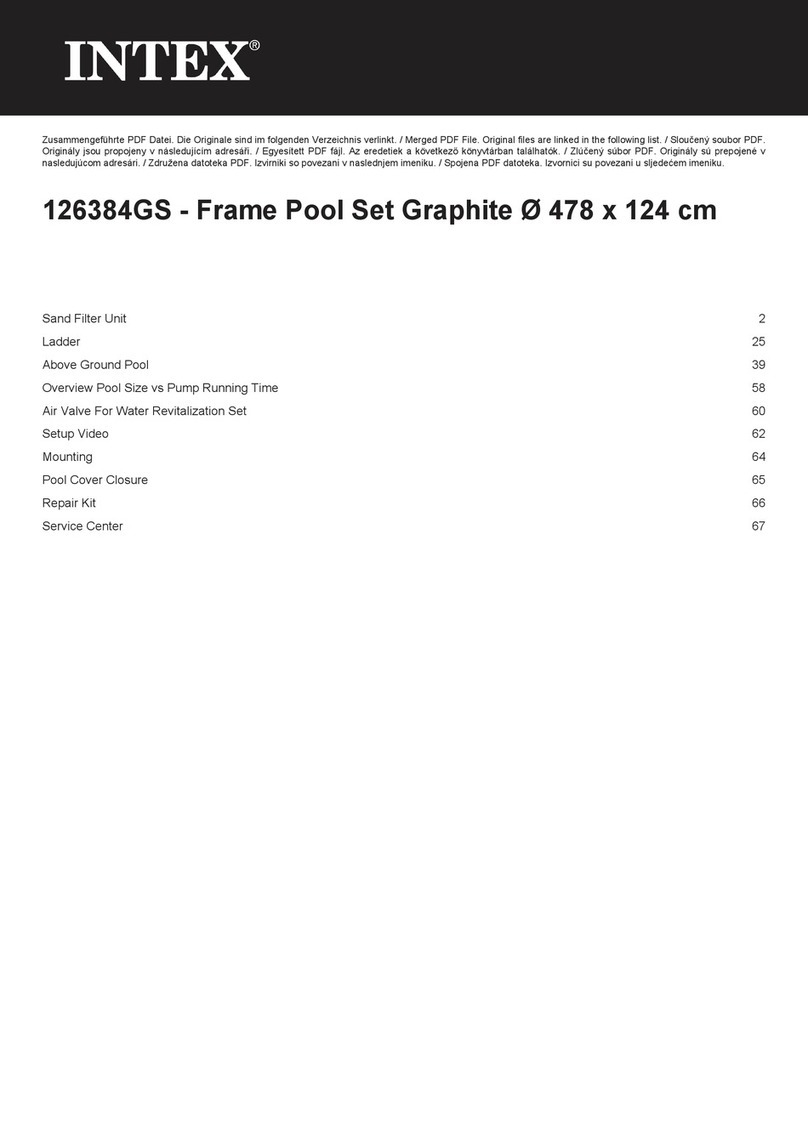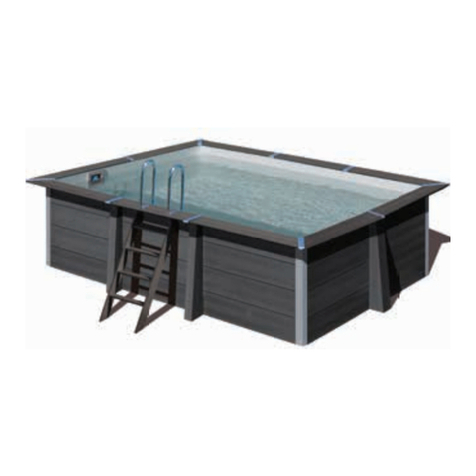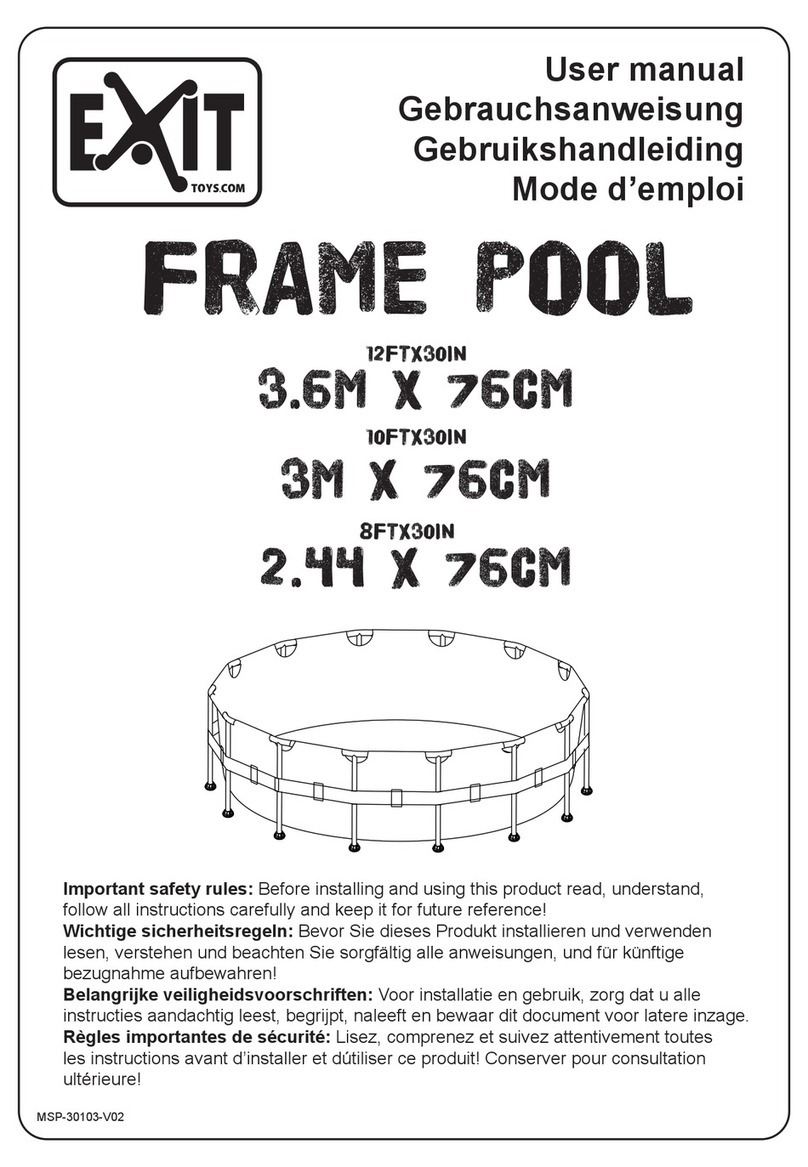BENIFERRO ZWMX7525-P User manual

1
Full Manual https://beniferro.eu
ZZZE3256
Swimming pool Twin water treatment on panel
ZWMX7525-P (without) flow monitor
ZWMX7526-P with flow monitor
ZWMX7528-P with flow and level monitor

2
Content
Introduction........................................................................................................................... 69
Specifications......................................................................................................................... 70
Installation............................................................................................................................... 5
Installation parts.................................................................................................................. 5
Installation of the water treatment panel ........................................................................ 72
Chlorine control via Rx: set the Rx Setpoint value............................................................ 81
Specification Ph addition................................................................................................... 81
Calibration and control chlorine /pH ................................................................................ 15
Connecting the flowmeter ................................................................................................ 15
Connect the level switch ................................................................................................... 82
Table1................................................................................................................................ 16
Winter-ready ..................................................................................................................... 84
Spring begins: .................................................................................................................... 18
Maintenance and inspection................................................................................................. 84
Maintenance ..................................................................................................................... 84
Warnings ........................................................................................................................... 85
Troubleshooting ................................................................................................................ 86
Manufacturer......................................................................................................................22

3
Introduction
This manual contains all the necessary information for installation, debugging and
maintenance. Read the manual thoroughly before opening or using the device. The
manufacturer of this product is not liable for any injury or damage to the product resulting
from improper installation or maintenance. It is essential that you follow the instructions in
this guide. Installation by qualified personnel is required.
○ Only a qualified installer, service center or authorized dealer can repair this product.
○ Maintenance and operation should be carried out according to the recommended time
and frequency specified in the manual.
○ Use only original standard parts. If you do not do this, your warranty will lapse.
○
The measuring probes must also be always kept moist during
transport (for any maintenance or repair work at the
supplier).).
Properties
○ Durable: The materials used are chlorine, acid (sulfuric acid) and alkali resistant. They are
resistant to long-lasting swimming pools (even with salt for salt electrolysis). The dosing units
are not suitable for use with hydrochloric acid (HCl).
○ Easy operation: The device is very comfortable and easy to use. Turn on the device and
set the desired pH value (acid) or redox value (chlorine).
○ Low costs: The operating costs are very low, because with proper use the pool water will
never turn green.
○
The pH and ORP system should be calibrated regularly and proper
operation checked using a sonic colour measurement method (e.g.
Poollab ZWMX1060).

4
Important notes
Adjusting the pH value and chlorine content of a new pool can take several hours to days.
During the start-up phase, it is important to carry out calibrations and measurements.
Incomplete grounding of the pool installation can have a negative effect on the measurement
result and thus lead to abnormal pH and chlorine values in the pool. .
Correct grounding is carried out as follows:
-The pool pipe after the filter pump is grounded via inline grounding to an independent
grounding pole.
-The pool pipe near the measuring probes is grounded via inline grounding on a second
independent grounding pole.
Use only city water, no rainwater or spring water.
Specifications
ZWWX7520-P
pH control
ZWMX2155
Slangenpomp
Chlorine control
ZWMX2155
Slangenpomp
Connection pool
50mm rubber ZALX120
Flow monitor
Optioneel ZPHS0008
Panel size
48 x 38 cm
Graffiti map
Harmo pool ref ZWMX7010
Relay card
Harmo pool ref ZWMX7011

5
Technical specifications
pH/RX Sensor measurement
Connection with BNC connector
Measuring range
pH: 5-9 +- 0,1
Rx 200- 999mV +- 10mV
Configuration
Via the display menu
Relay output
16 A AC1
Reproduction
Available
Dosing pumps
ZWMX2155
Power supply
230V ~, 50 Hz
Housing
IP65 IK07 Rohs
Installation
Wall mount with screws and plugs
Dimensions
480x380
Weight
12 kg
Power switch
Optional or already available with ZWMX7522-
P
Detection of acid and chlorine tank level
Optional
Installation
Installation parts
Be careful!
○ The electrical installation must be carried out in such a way that:
-The chlorine and acid pumps may not work if the filter pump
does not work. This can be done by adding a flow switch/
flow controller ZWMX3552-P to the installation or by using
the same flow line as the filter pump.
-Chlorine and acid With the ZWMX7522-P, the flow switch is already built into the
device.
-The chlorine and acid pumps can be switched off when the filter pump is in operation.
This can be done via the on/off button on the pumps themselves.
○ The addition of chemicals for the pool should be done after the pool accessories such as
heating, UV lamp, filter, etc.
○ Chlorine and acid can react with each other to form chlorine gas. Make sure that the
chemicals are outside and that they cannot come into contact with each other.
○It is recommended to install the water treatment unit in bypass configuration
○Install the water treatment unit on a solid surface or on the wall.
○ Always keep the product upright. If the product is tilted or lies on its side, the electrodes
cannot measure properly, resulting in incorrect measurements.

6
○ The product must be installed indoors. If you want to do this outdoors, you should contact
your supplier.
○ The dosing units should not be used with hydrochloric acid (HCl).
○ Acid and chlorine (liquid chlorine) should not be mixed. When mixed, chlorine gas is formed.
Storage must be carried out in such a way that the products cannot come into contact with
each other. (HCl)
○ The electronics of the unit (dosing units) must be installed indoors. Make sure that the
water cannot run over the unit in case of leakage.
○ Never connect the electronics or the device itself to an output of a frequency converter.
Chlorine and acid can react with each other and form chlorine gas. Make sure that the
chemicals are outside and that they cannot come into contact with each other.
○The dosing unit shall not be in the same circuit as the frequency converter used and shall be
at least 3 m away from the dosing unit.
○Calibrate the pH and Rx electrodes before first use and then "regularly".
Installation of the water treatment panel
1) Attach the water handling unit to a solid wall. Attach both the lower and upper part of the
panel.
2) Place the pH and chlorine electrodes in the electrode holders. Tighten the nut with pliers or a
wrench to tighten the cap. If you do not do this, there is a chance of a leak that is not covered
by the warranty.

7
3) Connect the water inlet and outlet in such a way that the water first passes along the pH
dosing cap and the pH measuring electrode and then along the redox measuring electrode and
the redox dosing cap. (according to the direction of the yellow arrows on the pipe) The default
setting is an installation in the bypass configuration:
4) Adjust the electrical connections so that
- The chlorine and acid pumps cannot work if the filter pump does not work, via the menu item
Flow switch (on).
- Of chlorine- in acid pumps can become disabled when of filter pump in action is.
Turn off the acid and chlorine dosing unit (button at the bottom left of the dosing pumps) for
the next steps during installation and calibration.
5 Connect the pH and redox measuring heads to the BNC connector at the designated points at
the lower left of the control unit:
Fuse with
timer
Filter pump

8
pH (left) Rx (right)
6) Start the filter pump.
7) Make sure that the installation has no water leakage.
8) Stop the filter pump. Remove the electrodes from the holder and calibrate the pH and redox
electrodes.
Be careful!
(1) (If you do not have a bypass configuration, you can place two rubber caps (product code:
ZFPX4640) in the electrode holders to prevent water from leaking from the electrode
holders during calibration.
(2) If you have a bypass, make sure that the dosing pumps cannot pump liquid when the
bypass to the dosing nipples is closed. This can be done by switching off the dosing
pumps themselves or by switching off the power supply
(3) Calibrating the electrodes may take a few minutes. For an accurate reading, it is
important to follow the steps below.
(4) Ensure that the calibration fluids used in the calibration always correspond to the
specified values and that the liquids are not contaminated.

9
9) Calibrate of probes
With the following steps, you will have calibrated the electrodes in no time:
There are 2 ways to calibrate:
Method 1: Calibration via calibration fluid
1. Immerse the measuring heads in the calibration fluids for pH (pH 7) and ORP (465-468
mV) and wait 5 minutes to reach equilibrium before proceeding with the calibration
procedure.
Press the pH and ORP buttons (top and bottom buttons)
separately for 10 seconds (top and bottom buttons)
As soon as the calibration starts, a screen is activated that shows what you are
calibrating. You can calibrate only Ph or rx only or both at the same time

10
<- A timer stops after 120 seconds and indicates whether the calibration
was successful
If the calibration is not successful, the following à Message is displayed
Reasons for a failed calibration:
- Poor calibration (try again)
- The calibration fluid is contaminated (replace the liquid). Recalibrate
- Probe defective (replace the probe) and recalibrate.
If Ph and Rx are properly calibrated, the screens are automatically hidden
After, about 2 minutes, the lights go out and you can read the values on the screen. If the
calibration is correct, the values are as follows:
a) pH 7,0 + 0,1
b) Redox 468 + -10 mV
If the values are not within the range described above, you can repeat the calibration
using the pH and ORP keys.
Method 2: Calibration using an alternative measurement method
10 Preparation of the pool water
Make sure that the pH value of the pool water is at least
between 7.2 and 8.5 and as close as possible to 7.4
Make sure that the chlorine stabilizer content (cyanuric acid) of the pool water is between 20-
40 ppm (20-40 g/ 10 m³)
11 Set parameters
A number of parameters need to be set. Press the center button. You will see the following
screen:

11
11.1) Language
You can set a (different) language. Press the middle button again. Then
use the top or bottom button to navigate to the languages Français,
Castellano, Italian, English, German. You confirm your choice of language
by pressing the middle button.
11.2) Dosing method: proportional or continuous
Press the bottom button. The setting "Dosing method" is now checked.
Press the center button to activate this setting. You will now see that
the dosing method Prop (= proportional) is selected. Press the middle
button again. The dosing method is now proportional.
Be careful!
You should NOT choose the salt option for the addition of liquid chlorine.
Explanation of the dosing method proportionally:
In the "Proportional" dosing method, the controller continuously goes through a cycle in which:
- pH and chlorine content are measured and stored for 40 seconds (no dosing is
currently used).
- The chlorine (if necessary) is dosed for 2 minutes.
- The pH min (if necessary) is dosed for 2 minutes.
The closer the pH value approaches the setting value, the less
the pump is running.
This dosing method (prop) is recommended for working with liquid chlorine and liquid pH
With this dosing method, pH and liquid chlorine are never dosed simultaneously
Explanation of the dosing method Cont:
- The pumps always run if pH and/or redox setpoint are not reached.
- If you decide to use this dosing method, the injection point for pH and chlorine should be at
least 2 metres apart.

12
11.3) PH+ of PH-
Press the bottom button. The "PH+ or PH-" setting is now highlighted.
Press the center button to activate this setting. On - sign appears. Press
the middle button again. You have now turned on the power supply
with PH-.
PH- should always be adjusted when salt electrolysis is used. When
chlorine is produced by the salt electrolysis unit, PH+ (NaOH) is formed as a
by-product.
PH- should always be adjusted when liquid chlorine is used. After all, liquid chlorine already
contains PH+, which is always added as a stabilizer.
PH- should always be adjusted when using the salt electrolysis. When chlorine is produced by the
salt electrolysis unit, PH+ (NaOH) is produced as a by-product.
It is not possible to add PH+ AND PHOTO: PH or PH+, never both at the same time.
In other cases, PH plus can be adjusted.
11.4) PH SP(SetPoint)
Press the bottom button. The "PH SP" setting is now activated. Press the
center button to activate this setting. You will now see a preset value.
Now you can move the value up or down with the top or bottom key.
Then confirm with the middle button. The value is now set according to
your needs.
As a rule, the pH value is set to 7.4.
11.5) Rx SP (Redox SetPoint)
The redox is a measure of the chlorine content.
During commissioning, we recommend setting the set point to 700 mV,
as described above for the pH value. After the first commissioning,
measure the chlorine content using a colour method. If necessary,
adjust the redox setpoint (decrease if the chlorine content is too high,
increase if the chlorine content is too low).
Read carefully the chapter "Setting the Rx setpoint" in the manual
L

13
11.6) Flow monitor no, and
Here you can indicate whether the unit is equipped with a power switch. If you enter YES, the
device assumes that a power switch is active.
If there is a water flow, the Ph and chlorine dosing pumps can function. When there is a water
flow, the dosing pumps do not work
A flow switch is included in the ZWMX7525 version, but not in the
ZWMX7520-P version.
11.7) Security alarm on or off or info
The alarm function is prepared to ensure the safe operation of this device and the swimming
pool.
Alarm on:
The alarm screen shows the following:
- pH too high (pH >8.5)
- pH too low (pH<5.5)
- pH setpoint not reached after 200 minutes of dosing
- Redox too low (<100)
- Rx Setpoint not reached make 400 minutes dosage
The alarm function is necessary to warn the
user of abnormal behaviour of the unit and to
prevent a very large dose of a pH liquid from
being dosed or from dosing or generating too
much chlorine.
The alarm message disappears when the middle menu button (reset)
is pressed or after a power failure.
If after resetting the alarm function the values deviate as described above, the alarm will
continue.
Swimming is not allowed in the pool if the "alarm" indicates a deviation
Alarm off:

14
Never use the device in the alarm OFF position during normal use. If you turn off the alarm, the
alarm function described above will not work for 240 minutes.
The alarm OFF mode is only used to check the values of a swimming
pool that deviate significantly. (as at the first start)."
For example, the pH value can be very high and the Rx value very
low when the pool is first put into use. In this case, you need
to use the alarm function "OFF" to check the pH and chlorine.
When the "alarm off" function is used, swimming in the pool is not allowed
12) Install the suction nipple.
Place the pH suction cup in the acid tank and the chlorine suction cup in the chlorine tank.
It is recommended not to lower the suction cup to the bottom of the jug. If something goes
wrong during dosing, the entire container with chlorine or acid is not pumped into the pool.
13) Start the device
Start the installation by turning on the flow of the pump and the dosing unit.
Switch on the pH dosage (via the switch on the bottom of the dosing pump) until the pH value is
between 7.2 and 7.6. If the pH value is less than 7.2: add pH plus manually to the pool water.
Once the pH value is in the range of 7.2 to 7.6, switch on the chlorine dosage.
With the "Prop" dosing method, the acid and chlorine pumps never work simultaneously.
Make sure that the dosing nipples for acid and chlorine do not leak and that acid and chlorine
are dosed effectively.
14)Verifieer
Regularly check the operation of the probes and the settings by measuring the pH value and the
chlorine content using an alternative method (colour measurement). If necessary, adjust the set
values of the system.
Chlorine control via Rx: set the Rx setpoint value
The Rx (redox) is a measure of the chlorine content (oxidizing capacity) of the pool water. The
higher the Rx, the higher the chlorine content.
the Rx is expressed in mV (millivolts), the chlorine content in ppm (parts per million).
The chlorine content in a swimming pool is ideally between 1 and 1.5 ppm.

15
There is no clear link between Rx and ppm chlorine, but usually an Rx of 700-750 mV
corresponds to a chlorine content of 1 to 1.5 ppm.
Therefore, the chlorine content should be checked at regular intervals at commissioning and
thereafter using a color measurement method (e.g. Poollab ZWMX1060). If it turns out that the
chlorine content is too high, the Rx setpoint should be lowered. If it is determined that the
chlorine content is too low, the Rx setpoint should be increased. If necessary, repeat this
procedure several times until the chlorine content remains constant between 1 and 1.5 ppm.
As an extra safety measure, we recommend that you do not lower the suction cup to the
bottom of the jerry can when starting. If something goes wrong during dosing, the whole can of
acid will not be pumped into the pool.
Read the safety instructions carefully before using chemicals.
Specification pH addition
Since pH + has been added to liquid chlorine, the pH value must be corrected with pH minus.
We recommend the use of 15%-30% sulfuric acid. Boe "weaker" the sulfuric acid, boe more
accurately the pH dosage will work.
In the exceptional case that the pH falls below 7.2, it is best to bring it back into the zone 7.2-7.6
by adding pH plus.
As an extra safety measure, we recommend that you do not lower the suction cup to the
bottom of the jerry can when you launch it
If something goes wrong with the dosage, the whole can of acid is not pumped into the pool
Read the safety instructions carefully before using chemicals.
Calibration and control chlorine /pH
The accuracy of the pH value and the chlorine content should be checked regularly (weekly) by
means of a thorough colour measurement (e.g. Poollab ZWMX1060).
Each system shall be calibrated at least once a year. In case of a long bathing season or if
there is a discrepancy between the colour method and the pH / Rx values, it is advisable to
carry out the calibration also every six months, i.e. twice a year. The procedure for
calibrating and setting the set point has already been described in detail above

16
Connecting the flow meter
For units manufactured in 2020 or later, a power switch can be mounted on the unit.
On the circuit board with the display, the "FS" connector is located at the bottom left.
These are connected to the two contacts of the power switch.
If no flow rate is detected, neither the acid nor chlorine pump runs and an alarm is triggered.
Connect the level switch
For units manufactured in 2020 or later, 2 level switches can be mounted on the unit.
On the circuit board with the display, the connections "WLH" and "WLL" are located in the
middle and bottom right. These are connected to the 2 contacts of the level switch. Connect the
WLH connection to the level switch in the acid tank and the WLL connection to the level switch
in the chlorine tank.
When a low level is detected, the pump involved stops pumping and an alarm is generated
Table 1
The following table shows the ratios between mV, pH and the corresponding chlorine content in
ppm. For example, your device has the following values on the screen: pH 7.2 and ORP of 740,
then your pool water has a chlorine content of 1.2 ppm.
Attention: this table is not always correct. Products such as flocculants, wall cleaners, settling
agents, sulfates, copper sulphate, extreme shredder (Chloramines), electromagnetic
interference and/or less than optimal grounding can cause an Rx of 700-750 mV NOT to
correspond to a chlorine content of 1-1.5 ppm. This is often a temporary phenomenon that
mainly occurs with salt electrolysis.
Power switch
connect
Connecting the acid level switch
Level switch
Connecting chlorine

17
A color measurement with a solid-state device (e.g. Poollab ZWMX1060) gives the best
indication of the chlorine content in the swimming pool.
Free chlorine ORP/mV vs pH
pH
ORP/Mv
pH
6,9
7
7,2
7,3
7,4
7,5
7,6
7,7
7,8
7,9
8
8,1
8,2
ppm
mV
507
505
502
500
499
497
496
494
493
491
490
488
487
0,2
mV
561
558
553
550
548
546
544
541
539
536
534
532
529
0,3
mV
599
596
590
586
583
580
577
574
571
568
565
562
559
0,4
mV
629
625
618
615
611
607
604
600
597
593
590
586
583
0,5
mV
652
648
640
637
632
629
625
621
617
613
610
605
602
0,6
mV
663
658
650
646
642
638
634
630
626
622
618
614
610
0,65
mV
673
669
660
656
651
647
643
639
635
630
626
622
618
0,67
mV
682
677
668
664
660
663
651
647
642
638
634
629
625
0,75
mV
690
686
677
672
668
655
659
654
650
645
641
636
632
0,8
mV
698
694
684
680
675
670
666
661
657
652
647
643
638
0,95
mV
706
702
692
687
682
677
673
668
663
658
654
649
644
0,9
mV
713
708
698
694
689
684
679
674
669
664
659
654
650
0,95
mV
720
715
705
700
695
690
685
680
675
670
665
660
655
1
mV
733
727
717
712
707
701
696
691
686
680
675
670
665
1,1
mV
744
739
728
722
717
712
706
701
695
690
685
679
674
1,2
mV
755
749
738
732
727
721
716
710
705
699
694
688
682
1,3
mV
765
759
747
742
736
730
724
719
713
707
702
696
690
1,4
mV
774
768
756
750
744
738
732
727
721
715
709
703
697
1,5
mV
790
784
771
765
759
753
747
741
735
728
722
716
710
1,7
mV
798
792
779
773
766
760
754
748
741
735
729
722
716
1,8
mV
812
805
792
785
779
773
766
760
753
747
740
734
727
2
mV
824
818
804
797
731
784
777
771
764
757
751
744
737
2,2
mV
841
834
826
813
806
800
792
785
778
771
764
757
751
2,5

18
Winter-ready
Be careful!
If you do not protect your product from the winter, this can lead to damage that is no longer
covered by the warranty.
In areas where it freezes a lot, you need to protect the pump, filter and dosing unit from frost.
It is recommended to store the dosing units indoors in a dry and warm environment. The
electrodes must be immersed in KCl storage fluid in a frost-free environment. (ZWWX7168)
The PVC pipes must be anhydrous.
Spring begins:
If your measuring equipment was protected during the winter, follow these steps before
restarting the system in the spring.
1. Calibrate the electrodes.
2. Check that the check valves in the dosing nipples are not clogged.
3. Make sure that the installation does not leak when the whole
thing is under pressure and the dosing pumps are running. Replace
the dosing hoses and the peristaltic dosing tube every two years
as a preventive measure.
Maintenance and inspection
Maintenance
o Regularly check the operation of the electrodes and the settings by measuring the pH
value and the chlorine content using an alternative method (colour measurement). If
necessary, adjust the setpoints of the installation.
o Regularly check the hose in the peristaltic pump. Replace this tube immediately in case of
leakage. It is advisable to replace this hose preventively every year.
o Check the injectors regularly for leaks. Replace these nozzles immediately if there is a leak.
o Regularly check the power supply and cable connection. If the pump is working
abnormally, turn it off and call a qualified technician.

19
Maintenance of peristaltic pumps
-The pump hose has reached the end of its service life after 500/600 operating hours
(chemical compatibility) and must be replaced annually
-The hoses of the drain and supply pipe must be replaced every two years.
-The nozzles must be descaled and rinsed every two years. The limescale can block the
supply or return. We recommend the use of chlorine with anti-limescale agent
(ZWCX1232).
-The drain and supply pipes must be replaced 2 times a year. .
-A maintenance kit is available: ZWMX2201-Z
-The pumps must always be higher than the supplied liquids.
-Use the correct, prescribed products for the peristaltic pumps and the Santoprene
hose (to be replaced annually as indicated).
Warnings
○Improper installation may cause an electrical or chemical hazard that could result in
serious injury
○Never mix acid and liquid chlorine. These react to form dangerous chlorine gas
○Keep the installation and chemicals out of the reach of children. Always wear protective
gloves and goggles when working on the installation.
○NEVER make internal adjustments to the dosing unit.
○If you are not familiar with the pool filter system and the dosing unit:
-Try not to rent anything without consulting your supplier, a professional pool
contractor.
-Read the entire installation and operating manual before using the dosing unit.

20
-
Note: Very important
1. Always turn off the device if it has been repaired or maintained.
2. When sending the device for inspection, make sure that the measuring
probes are always in a storage liquid when you send them. If the measuring
probes are dry for 3 to 4 hours, this may affect the following measurements
and lead to incorrect measurements.
HOW TO RINSE A DOSING UNIT
We take the extraction nipples from the acid and chlorine tank.
We put 2 buckets of lukewarm water in the place of the buses
Place the suction nipple in the buckets of water and run the dosing unit for half an hour, the
setting being such that the dosing pump system rotates.
After 30 minutes, remove the suction nipple from the water and let the dosing unit run for
another 5 minutes so that all the water is out of the hoses.
You can now safely ship your dosing unit
Troubleshooting
PROBLEEM
CAUSE
SOLUTION
The screen does not light up
Supply voltage is missing
Stuurspanning
Acid pump does not dose
Switch under the dosing pump
is set to "O"
Set the switch to "1"
pH control settings are wrong:
pH+ while pH is dosed (or vice
versa)
Check the settings
A level indicator is connected
that gives the wrong contact
Disconnect level indicator
A flow switch is connected and
indicates that there is no flow
Check the flow rate and flow
switch (go to the flow switch
setting: no).
The acid pump continues to
dose
Setpoint not yet reached
No action required
Wrong parameter setting: pH +
while pH- is dosed (or vice
versa)
Parameter aanpassen
Relays remain on
Contact the supplier.
Acid pump only doses
occasionally
The acid pump stands for
proportional dosing
No action required
Chlorine pump does not dose
Switch under the dosing pump
is set to "O"
Set the switch to "1"
Rx control settings are incorrect
Check the settings
This manual suits for next models
2
Table of contents
Languages:
